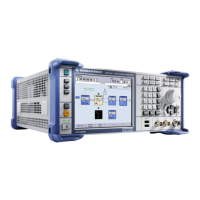Remote Control Basics
R&S
®
SMBV100A
426Operating Manual 1407.6062.32 ─ 08
Fig. 6-2: The status-register model
Description of the five status register parts
The five parts of a SCPI register have different properties and functions:
●
CONDition
The CONDition part is written into directly by the hardware or the sum bit of the next
lower register. Its contents reflect the current instrument status. This register part can
only be read, but not written into or cleared. Its contents are not affected by reading.
●
PTRansition
The two transition register parts define which state transition of the CONDition part
(none, 0 to 1, 1 to 0 or both) is stored in the EVENt part.
The Positive-TRansition part acts as a transition filter. When a bit of the
CONDition part is changed from 0 to 1, the associated PTR bit decides whether the
EVENt bit is set to 1.
– PTR bit =1: the EVENt bit is set.
– PTR bit =0: the EVENt bit is not set.
This part can be written into and read as required. Its contents are not affected by
reading.
●
NTRansition
The Negative-TRansition part also acts as a transition filter. When a bit of the
CONDition part is changed from 1 to 0, the associated NTR bit decides whether the
EVENt bit is set to 1.
– NTR bit =1: the EVENt bit is set.
– NTR bit =0: the EVENt bit is not set.
This part can be written into and read as required. Its contents are not affected by
reading.
●
EVENt
The EVENt part indicates whether an event has occurred since the last reading, it is
the "memory" of the condition part. It only indicates events passed on by the transition
filters. It is permanently updated by the instrument. This part can only be read by the
user. Reading the register clears it. This part is often equated with the entire register.
Status Reporting System

